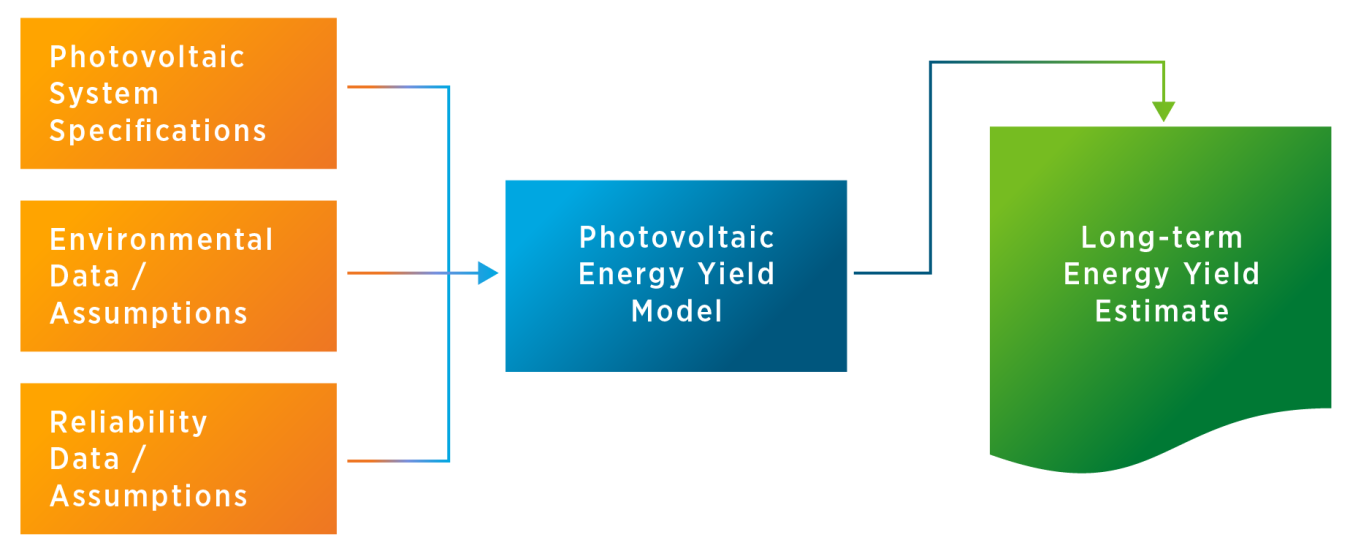Photovoltaic (PV) solar energy systems are expected to operate for at least 20 to 30 years. The U.S. Department of Energy (DOE) Solar Energy Technologies Office (SETO) supports research and development (R&D) to extend the useful PV system life to 50 years. How well a system performs during its lifespan directly affects project cash flows, which largely determine the value of those systems. It also affects operation and planning activities for the electric grid.
There are many different applications that give PV system owners the ability to model the operation of PV systems before they are constructed, which helps to reduce financial and reliability risks. These models use meteorological inputs and a mathematical representation of the system to calculate the energy that will be generated over any time interval of interest—from minutes to decades.

SETO’s Modeling of PV Systems white paper (PDF) discusses the current and expected modeling capabilities available to PV system owners. Below, you will find commonly asked questions about PV models and how they can help PV system owners.
PV models estimate how much energy can be generated by a PV array by simulating operation under realistic conditions and over extended periods of time. The ability to model PV system behavior is important in a wide range of applications from project development to power plant monitoring and electric grid planning.
Users provide information like electrical characteristics of the PV modules, the electrical connection topology between the modules and the inverters, the specifications of the inverters, the geographic coordinates, orientation and spacing of the solar array, the tracking algorithms of the trackers, and the shading conditions. Additionally, some models take environmental factors into consideration, like solar radiation, ambient temperature, wind speed and direction, volume of rain and snow, reflectance of the ground, and soiling.
While the models provide very accurate information that should inform decision-making processes, no model is perfect. There is some built-in uncertainty due to imperfect observations and the approximating nature of empirical models. Additionally, the specification information comes with its own errors and discrepancies from the as-built reality. Finally, if historical environmental data are used as inputs to estimate future performance, the reliability of the observations or their proximity to the real environment of the system can affect uncertainty. An accurate assessment of risks associated with the technical performance of PV systems needs to account for these uncertainties in models, specifications, input data, and epistemic assumptions.
For meteorological data, the National Solar Radiation DataBase (NSRDB) can provide more than 20 years of irradiance, surface temperature, and other ancillary data with a minimum resolution of 4x4 km and 30 minutes. NSRDB data are generated from satellite imagery, environmental datasets, and a physics-based model of radiation transfer in the atmosphere. The data are not post-processed using ground measurements and consequently carry a level of uncertainty that does not meet the requirements of project financing. However, the database is used for feasibility studies or large-scale analyses by the industry and the national laboratories.
The PV Fleet Performance Initiative analyzes the multi-year performance of hundreds of PV systems and derives information about the major performance loss factors, such as soiling, shading, electrical mismatch, wiring resistance, degradation rate, and availability. While the reports contain significantly more detail, it is worth mentioning that the analysis of the more than 1,000 systems in the study points to an average inverter availability of 97.7% compared to a commonly assumed 99%.
More reliability-related data has been collected by projects such as the PV Reliability Operations and Maintenance (PVROM) project, led by Sandia National Labs and the Electric Power Research Institute. PVROM refers collectively to the tool developed for the collection of data on system specification, performance, availability, and maintenance activities; the database constructed to house those datasets; and the project that created the tools, collected the data, and performed the analysis. The project has been able to provide data-driven PV system reliability and operation and maintenance findings that can be utilized to notify more strategic long-term thinking around solar plant operation and value.The introduction and adoption of new technologies such as new solar cell materials, bifacial modules, and grid-forming inverters, requires not just incremental improvement of existing models, but the introduction of new models, too. SETO is committed to supporting the PV modeling community through funding opportunities relevant to the varied challenges and through the dissemination of the models and algorithms developed by national labs in conferences, publications, and open-source software repositories. SETO encourages the greater community to actively engage in open-source software projects that tackle PV system or component modeling challenges. The permissive licensing for those projects is meant to promote low-overhead use by non-profit and for-profit entities alike.
See more solar energy resources and learn about the Solar Energy Technologies Office's research areas.

